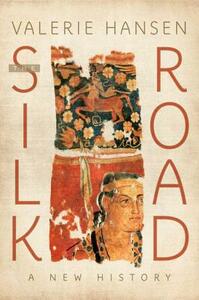Take a photo of a barcode or cover
Modern historians hate the idea of the silk road. Hate, hate, hate it! And they love nothing more than to disabuse people of the idea of its existence. Most are content to say something like "the silk road is an outdated historical construct; it was not one road. Rather, it was a complex network of trade routes that spanned Eurasia, from the steppes to Malacca, from Japan, to Ireland with few people making the entire journey."
These are all academic quibbles though. When someone says "silk road" you know what they mean. The historians know what you mean (they just need to deny the existence of it to puff up the importance of their thesis on the fur exports of the Yenesei Kyrgyz tribes or whatever). The silk road is land trade between China and the west, largely involving silk. There's only so many routes it can take: the pastoralists in the steppe won't let trade through unmolested; The straights of Malacca, sojourning the bulk of the trade, isn't really what we have in mind when we say "road". This leaves just a few mountain passes adjacent to the Tarim basin to get goods through. It's an area where goods, merchants, envoys, and armies are funneled, resulting in cultural exchange.
Valerie Hansen takes this definition we know and love and runs with it, focusing mostly around oasis polities in the Taklamakan, with a few excursions to Sogdia and Chang'an. However, she has her own thesis: trade didn't happen on any meaningful scale. All these oasis states? Yeah, they just had local economies with the occasional peddler or some envoy from a forgotten satrap stopping through to make tribute to the emperor. Silk was of great importance, but was mostly used as a currency since the Chinese dynasties, most notably the Tang, paid their garrisoned soldiers with it, and it trickled down into the local economy.
Hansen deftly weaves her narrative chronologically and geographically, starting with the earliest finds we have in Niya and Loulan, and devotes each subsequent chapter to another oasis town and the wonderfully preserved, but fragmentary documents found therein. Kucha, Turfan, Mt. Mugh, Dunhuang, and Khotan are all addressed in detail as the centuries progress. The bulk of the book is dedicated to detailing what we know of these societies economies, and what little we know points to little trade. The transfer of texts and technologies was mostly done by refugees according to Hansen.
It's hard to square this argument with the wealth of the Sogdians, a Persian people who settled throughout these city states and China itself. The Sogdians maintained regular communication with their homeland. This can be evinced from the famed (and cited) Sogdian letters. Tombs of Sogdians are exceeded in opulence only by tombs of Emperors. The lasting reputations of the Sogdians as wealthy merchants is apparently pervasive throughout Chinese folklore, but this is swept under the rug because there is evidence of poor Sogdians in China, as if Sogdian society couldn't be stratified. As if a large, successful population couldn't produce a few failsons.
The tomb of An Jia is described by Hansen as only having carvings of diplomatic scenes, not mercantile ones. Thus he couldn't have been a merchant. Come on, you don't get a tomb with multiple panels carved by artisans without money.
The hand waiving on some examples gets even more absurd. A document inventorying a foreign "Iranian lock" is interpreted as only being Iranian in style and made locally in Dunhuang, sort of like "French fries" are made in America. Seriously, this argument is put forth: a lock is apparently much too heavy to be brought on the trip, and any goods brought by peddlers and occasional envoys must have been low weight, high cost items like gemstones. As if Persian people coming from a Persian area wouldn't lock up their Persian gemstones, that we agree must have come from that area, with their Iranian made lock!
Hansen says anyone disagreeing with her must admit that the documents don't support large scale trade. Perhaps not, but even with the documents, it really seems she is downplaying what trade there is evidence for. My issues with the thesis aside, the book is fantastic in its detail and a complete joy to read for anybody interested in the area, the religions covered, or even trade and anybody buying the book should opt for the version that includes the large selection of primary sources, most of which are hard to track down elsewhere.
These are all academic quibbles though. When someone says "silk road" you know what they mean. The historians know what you mean (they just need to deny the existence of it to puff up the importance of their thesis on the fur exports of the Yenesei Kyrgyz tribes or whatever). The silk road is land trade between China and the west, largely involving silk. There's only so many routes it can take: the pastoralists in the steppe won't let trade through unmolested; The straights of Malacca, sojourning the bulk of the trade, isn't really what we have in mind when we say "road". This leaves just a few mountain passes adjacent to the Tarim basin to get goods through. It's an area where goods, merchants, envoys, and armies are funneled, resulting in cultural exchange.
Valerie Hansen takes this definition we know and love and runs with it, focusing mostly around oasis polities in the Taklamakan, with a few excursions to Sogdia and Chang'an. However, she has her own thesis: trade didn't happen on any meaningful scale. All these oasis states? Yeah, they just had local economies with the occasional peddler or some envoy from a forgotten satrap stopping through to make tribute to the emperor. Silk was of great importance, but was mostly used as a currency since the Chinese dynasties, most notably the Tang, paid their garrisoned soldiers with it, and it trickled down into the local economy.
Hansen deftly weaves her narrative chronologically and geographically, starting with the earliest finds we have in Niya and Loulan, and devotes each subsequent chapter to another oasis town and the wonderfully preserved, but fragmentary documents found therein. Kucha, Turfan, Mt. Mugh, Dunhuang, and Khotan are all addressed in detail as the centuries progress. The bulk of the book is dedicated to detailing what we know of these societies economies, and what little we know points to little trade. The transfer of texts and technologies was mostly done by refugees according to Hansen.
It's hard to square this argument with the wealth of the Sogdians, a Persian people who settled throughout these city states and China itself. The Sogdians maintained regular communication with their homeland. This can be evinced from the famed (and cited) Sogdian letters. Tombs of Sogdians are exceeded in opulence only by tombs of Emperors. The lasting reputations of the Sogdians as wealthy merchants is apparently pervasive throughout Chinese folklore, but this is swept under the rug because there is evidence of poor Sogdians in China, as if Sogdian society couldn't be stratified. As if a large, successful population couldn't produce a few failsons.
The tomb of An Jia is described by Hansen as only having carvings of diplomatic scenes, not mercantile ones. Thus he couldn't have been a merchant. Come on, you don't get a tomb with multiple panels carved by artisans without money.
The hand waiving on some examples gets even more absurd. A document inventorying a foreign "Iranian lock" is interpreted as only being Iranian in style and made locally in Dunhuang, sort of like "French fries" are made in America. Seriously, this argument is put forth: a lock is apparently much too heavy to be brought on the trip, and any goods brought by peddlers and occasional envoys must have been low weight, high cost items like gemstones. As if Persian people coming from a Persian area wouldn't lock up their Persian gemstones, that we agree must have come from that area, with their Iranian made lock!
Hansen says anyone disagreeing with her must admit that the documents don't support large scale trade. Perhaps not, but even with the documents, it really seems she is downplaying what trade there is evidence for. My issues with the thesis aside, the book is fantastic in its detail and a complete joy to read for anybody interested in the area, the religions covered, or even trade and anybody buying the book should opt for the version that includes the large selection of primary sources, most of which are hard to track down elsewhere.
informative
medium-paced
The Silk Road was neither a road nor was silk the main product traded. It was actually many roads and silk was more often used as currency than clothes. It was active from the 2nd center BCE until the 14th century CE and carried language and customs more than anything else.
There was a lot of talk of the spread of Buddhism, which as a Buddhist, I enjoyed. There was a lot of talk about the inventories found on old documents, which I didn't enjoy. Not as much. It got too much in the weeds for me. But the fact that paper was used as padding for burial clothes, was fascinating.
It was a solid book for sure, but there was a bit too much redundancy as the authors painstakingly detailed the contents of material found on those documents and in crypts. It'd make a great research book but wasn't that great for the average Joe. Or in this case, average Brad.
There was a lot of talk of the spread of Buddhism, which as a Buddhist, I enjoyed. There was a lot of talk about the inventories found on old documents, which I didn't enjoy. Not as much. It got too much in the weeds for me. But the fact that paper was used as padding for burial clothes, was fascinating.
It was a solid book for sure, but there was a bit too much redundancy as the authors painstakingly detailed the contents of material found on those documents and in crypts. It'd make a great research book but wasn't that great for the average Joe. Or in this case, average Brad.
informative
slow-paced
A very informative book on a topic I knew nothing about, and now I feel I have a good overview even of the state of research in the field. Could be perhaps a bit more vivid with some of the descriptions, but still a very interesting read.
An excellent retelling of the Silk Road trade routes examining primary documents and archaeological evidence to provide a more accurate depiction of life in Central Asia in the first millennium. Where most texts focus on religion, politics, or trade, Hansen focuses on the local level, painting detailed strokes and weaving it together with the broader history. This work is certainly academic, like most works on this region, and I wouldn't recommend it as a casual read unless you're very keen on historical deconstruction.
New archaeological discoveries (along with satellite imagery, DNA analysis, models of climate change and more open relationships with the Chinese and the Russians) have made possible a reassessment of the links in the chain of civilizations across Central Asia that made up the Silk Road for nearly two thousand years. Fortuitous discoveries of paper documents recycled into funeral accessories (meticulously folded paper dolls, furniture, paper wrappings for the deceased)reveal tax receipt, pawn tickets, bills of lading, practice copying religious texts and discarded border crossing authorizations, most of which points to cycles in which good government guaranteed safe passage and orderly transit, while times of political insecurity reduced desert towns to poverty and subsistence. Along the way, the material culture suggests extreme syncretism of religions (Coptic and Syriac Christians, Muslims, Buddhists of several flavors, Zoroastrians and their Manichean cousins, Confucian scholars and Hindus) and aesthetic preferences. This is beautifully presented recovery of a lost world through painstaking language translations and reconstruction of evidence ranging from account books to teeth.
I am surprised at how popular this difficult-to-read book seems to be. I wonder if it's just because the book is so disruptive and disruption is in style these days. She bases a lot on Dunhuang records, really on the paucity of Dunhuang records, but what if large trading caravans bribed their way out of the records? How complete are the records of this sort anyway? The author, who I have met and heard lecture in person, wrote this when she was just starting out in her career in history and I wonder if she would still write it the same way today.
Hensen presenta una nueva historia del Camino de la seda, una historia que es menos épica que la imagen popular que se tiene de esta ruta, peor no por ello menos interesante. Respaldada en las investigaciones arqueológicas a lo largo de todo el camino, ofrece una imagen en la que la ruta llevaba pocos productos, pero que fue esencial en el transporte de ideas y tecnologías, así la seda, no sólo como objeto sino como tecnología de extracción de un textil pasó por ella, así el budismo llegó a China desde la India, así el papel llegó a Persia (y desde ahí a Europa); era, según Hensen, una gran ruta hecha de rutas locales, en la que pocos mercaderes iban de un extremo a otro (era más común que algunas mercancías pasaran de mano en mano a través de toda la ruta).






